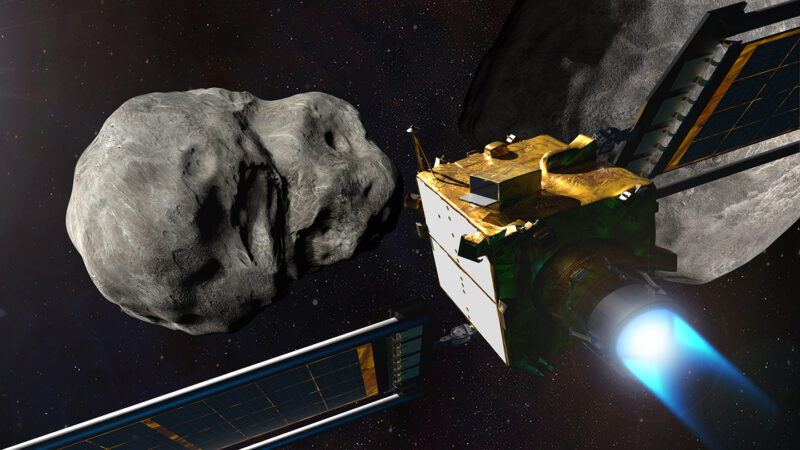Mission management rooms not often rejoice crash landings. However the collision of NASA’s DART spacecraft with an asteroid was a smashing success.
At about 7:15 p.m. EDT on September 26, the spacecraft hurtled into Dimorphos, an asteroid moonlet orbiting a bigger area rock named Didymos. The mission’s objective was to bump Dimorphos barely nearer to its father or mother asteroid, shortening its 12-hour orbit round Didymos by a number of minutes.
The Double Asteroid Redirection Take a look at, or DART, is the world’s first try to alter an asteroid’s movement by ramming an area probe into it (SN: 6/30/20). Neither Dimorphos nor Didymos poses a risk to Earth. However seeing how properly DART’s maneuver labored will reveal how straightforward it’s to tamper with an asteroid’s trajectory — a technique that would defend the planet if a big asteroid is ever found on a collision course with Earth.
“We don’t know of any massive asteroids that might be thought of a risk to Earth which can be coming any time within the subsequent century,” says DART staff member Angela Stickle, a planetary scientist on the Johns Hopkins College Utilized Physics Laboratory in Laurel, Md. “The rationale that we’re doing one thing like DART is as a result of there are asteroids that we haven’t found but.”

Astronomers have noticed nearly all of the kilometer-size asteroids within the photo voltaic system that would finish civilization in the event that they hit Earth, says Jessica Sunshine, a planetary scientist on the College of Maryland in School Park who’s additionally on the DART staff. However in terms of area rocks round 150 meters large, like Dimorphos, “we solely know the place about 40 % of these are,” Sunshine says. “And that’s one thing that, if it did hit, will surely take out a metropolis.”
Dimorphos is a protected asteroid to present an experimental nudge, says Mark Boslough, a physicist at Los Alamos Nationwide Laboratory in New Mexico who has studied planetary safety however isn’t concerned in DART. “It’s not on a collision course” with Earth, he says, and DART “can’t hit it exhausting sufficient to place it on a collision course.” The DART spacecraft weighs solely as a lot as a few merchandising machines, whereas Dimorphos is regarded as practically as hefty as Egypt’s Nice Pyramid of Giza.
After a 10-month voyage, DART met up with Didymos and Dimorphos close to their closest method to Earth, about 11 million kilometers away. Up till the very finish of its journey, DART may see solely the bigger asteroid, Didymos. However about an hour earlier than affect, DART noticed Dimorphos in its area of view. Utilizing its onboard digital camera, the spacecraft steered itself towards the asteroid moonlet and slammed into it at some 6.1 kilometers per second, or practically 14,000 miles per hour.

NASA
DART’s digital camera feed went darkish after affect. However one other probe close by is anticipated to have caught the collision on digital camera. The Gentle Italian CubeSat for Imaging of Asteroids rode to Dimorphos aboard DART however indifferent a few weeks earlier than affect to look at the occasion from a protected distance. Its mission was to whiz previous Dimorphos about three minutes after DART’s affect to snap footage of the crash web site and the ensuing plume of asteroid particles launched into area. The probe is anticipated to beam photos of DART’s demise again to Earth inside a few days.
“I used to be completely elated, particularly as we noticed the digital camera getting nearer and simply realizing all of the science that we’re going to be taught,” stated Pam Melroy, NASA Deputy Administrator, after the affect. “However one of the best half was seeing, on the finish, that there was no query there was going to be an affect, and to see the staff overjoyed with their success.”
DART’s affect is anticipated to shove Dimorphos into a better, shorter orbit round Didymos. Telescopes on Earth can clock the timing of that orbit by watching how the quantity of sunshine from the double asteroid system modifications as Dimorphos passes in entrance of and behind Didymos.
“It’s actually a superbly conceived experiment,” Boslough says. Within the coming weeks, dozens of telescopes throughout each continent will watch Dimorphos to see how a lot DART modified its orbit. The Hubble and James Webb area telescopes may get photos.
“It’ll be actually attention-grabbing to see what comes out,” says Amy Mainzer, a planetary scientist on the College of Arizona in Tucson who isn’t concerned in DART. “Asteroids have a manner of peculiar us,” she says, as a result of it’s exhausting to know an area rock’s exact chemical make-up and inner construction based mostly on observations from Earth. So Dimorphos’ movement post-impact could not precisely match researchers’ expectations.
The DART staff will evaluate information on Dimorphos’ new orbit with their pc simulations to see how shut these fashions had been to predicting the asteroid’s precise conduct and tweak them accordingly. “If we will get our fashions to breed what truly occurred, then you should utilize these fashions to [plan for] different eventualities that may present up sooner or later” — like the invention of an actual killer asteroid, says DART staff member Wendy Caldwell, a mathematician and planetary scientist at Los Alamos Nationwide Laboratory.
“It doesn’t matter what occurs,” she says, “we’ll get data that’s worthwhile to the scientific neighborhood and to the planetary protection neighborhood.”



